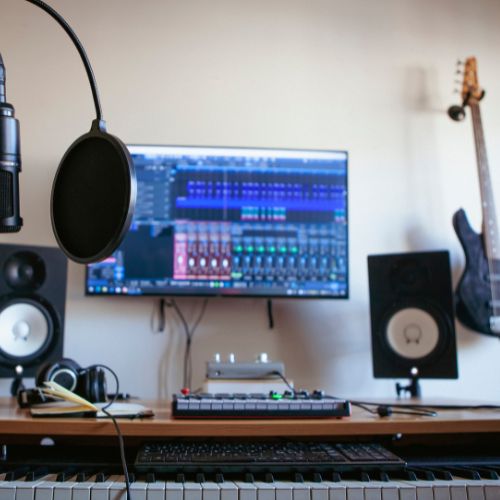
Behind the Scenes: How Music Producers Create Chart-Topping Hits
When you hear a chart-topping hit on the radio or streaming platforms, it’s easy to think about the singer or band behind it. But behind every successful song lies the intricate and often unseen work of music producers. These are the creative minds responsible for shaping the sound, mood, and overall feel of a track. Whether they’re working with top pop stars or up-and-coming indie artists, music producers play a pivotal role in bringing hit songs to life.
In this guide, we’ll take you behind the scenes to explore how music producers create chart-topping hits. From initial concept to final mix, we’ll uncover the key steps involved in producing a successful track, the tools they use, and the creative decisions that turn a song into a hit.
The Role of a Music Producer
A music producer is essentially the director of a song’s creation. Their responsibilities can vary widely depending on the artist and the type of project, but typically they:
- Guide the overall vision of the track, ensuring the song achieves the desired sound and feel.
- Collaborate with songwriters, artists, and instrumentalists to craft the music.
- Arrange and layer sounds, combining instruments, vocals, and effects in a way that enhances the song’s emotional impact.
- Manage technical aspects of the recording, including overseeing the mixing and mastering processes.
- Provide feedback on vocal performances, ensuring the artist delivers their best take.
Producers often work in close partnership with the artist, helping them realize their vision while also bringing their own creative flair to the project.
Step-by-Step: How Producers Create a Hit Song
Let’s break down the process of producing a chart-topping hit, from the initial idea to the final polished track.
1. Initial Concept and Songwriting
The production process begins with an idea. This could be a melody, a beat, or a lyrical theme. Sometimes producers come up with these ideas themselves, or they may work with songwriters to create the foundation of a track.
For example, a producer may start by laying down a simple beat or playing around with a melody on a keyboard. This foundational idea is then developed into a full song structure—verses, chorus, and bridge.
Key Tools:
- Digital Audio Workstations (DAWs) like Logic Pro, Ableton, or FL Studio are used to create beats, melodies, and harmonies digitally.
- Virtual instruments and sample libraries provide access to a wide range of sounds, from realistic orchestral instruments to synthesized beats.
2. Arranging the Track
Once the core song structure is in place, the producer begins arranging the track. This involves deciding which instruments or sounds will be used, and how they will be layered together. Producers often experiment with different combinations of instruments, drum patterns, and vocal effects to enhance the song’s impact.
Arranging a song is an art form in itself. It requires balancing simplicity with complexity, ensuring each element complements the others while creating dynamic shifts in energy. The arrangement helps guide the listener through the song, building up to climactic moments like the chorus.
Key Tools:
- DAWs are still central here, as producers manipulate different sound layers.
- MIDI controllers allow producers to play and record electronic instruments or trigger samples.
3. Recording Vocals and Instruments
The next step involves recording the vocals and any live instruments. Depending on the artist, this could take place in a professional recording studio or a home studio. During the recording process, the producer works closely with the artist, providing feedback on their vocal delivery and helping to capture the best performance.
In some cases, producers may also record additional instrumentalists or session musicians. These live elements can be layered with digital instruments to create a richer, fuller sound.
Key Tools:
- High-quality microphones and audio interfaces for capturing vocals and instruments.
- Soundproof studios ensure clear, professional-quality recordings.
4. Sound Design and Effects
Once the recordings are complete, producers dive into sound design. This is where they shape the tone and texture of the track by applying effects like reverb, delay, compression, and EQ (equalization). These effects can transform a song, making vocals sound more spacious, drums punchier, or melodies more ethereal.
Producers also experiment with creative sound design, manipulating samples or synthesizers to create unique sonic textures. Think of the signature vocal effects in Cher’s “Believe” or Daft Punk’s futuristic beats. These distinctive sounds help a track stand out and often become its defining feature.
Key Tools:
- Plugins for DAWs provide endless effects and sound manipulation options.
- Synthesizers allow producers to create new sounds from scratch, giving songs a unique identity.
5. Mixing the Track
Mixing is a crucial step in the production process, where the producer blends all the individual elements of a song—vocals, drums, bass, instruments, and effects—into a cohesive whole. The goal is to ensure that every sound has its place and that nothing is overpowering or buried.
During mixing, producers adjust volume levels, pan sounds to different sides of the stereo field, and fine-tune the EQ of each element to create clarity and balance. A well-mixed track sounds polished and professional, with each part of the song shining through clearly.
Key Tools:
- DAWs with advanced mixing capabilities.
- Studio monitors provide accurate playback for producers to hear every detail of the mix.
6. Mastering the Track
The final step in producing a chart-topping hit is mastering. This involves making subtle adjustments to the overall sound of the track to ensure it sounds great on any playback device—whether it’s high-end headphones, a car stereo, or a smartphone speaker. Mastering gives the song a final polish, enhancing its clarity and making it radio-ready.
Key Tools:
- Mastering plugins designed to adjust the overall EQ, compression, and loudness of the track.
- Professional mastering engineers sometimes handle this step, using specialized equipment to ensure the highest quality sound.
What Makes a Hit Song?
There’s no guaranteed formula for creating a chart-topping hit, but successful songs often share a few common traits:
- Catchy Hooks: Memorable choruses or melodies that stick in the listener’s mind.
- Strong Production: A polished, professional sound with a balance of instruments and vocals.
- Emotional Resonance: Songs that connect with listeners on an emotional level, whether through relatable lyrics or powerful music.
- Timing and Trend Awareness: Producers who stay ahead of or tap into current musical trends often find success in the fast-paced music industry.






